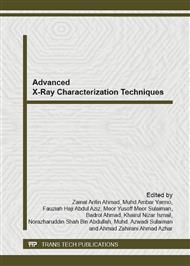p.252
p.257
p.263
p.268
p.273
p.278
p.284
p.289
p.295
Morphology and Intermetallics Study of (Sn-8Zn-3Bi)-1Ag Solder under Liquid-State Aging
Abstract:
This study investigated the effect of Ag addition on the morphology and growth rate of Cu5Zn8, Cu6Sn5 and Cu3Sn intermetallics in the Sn-8Zn-3Bi solder. The solder was prepared by mixing 1wt% of Ag into 99wt% of Sn-8Zn-3Bi solder. The intermetallics were formed by liquid-state aging, whereby the solders were reacted on Cu substrate above the melting temperature of the solder. The reflow was done at 250°C and 270°C at various soldering times. A scanning electron microscope (SEM) was used to observe the morphology of the intermetallic phase and energy dispersive X-ray (EDX) was used to identify the elemental composition. The Sn-8Zn-3Bi solder reacting with Cu substrate formed a single Cu5Zn8 intermetallic layer with a flat structure. On the other hand, the reaction between (Sn-8Zn-3Bi)-1Ag solder and Cu substrate produces Cu6Sn5 intermetallic. This Cu6Sn5 intermetallic has a scallop structure. As the soldering time increases, a second layer, identified as Cu3Sn starts to grow. The thickness of the intermetallics increases with aging temperatures and time. The addition of Ag into the Sn-8Zn-3Bi solder has significantly suppressed the formation of Cu5Zn8 intermetallic and promoted the growth of Cu6Sn5 intermetallic.
Info:
Periodical:
Pages:
273-277
Citation:
Online since:
December 2012
Authors:
Keywords:
Price:
Сopyright:
© 2013 Trans Tech Publications Ltd. All Rights Reserved
Share:
Citation:


